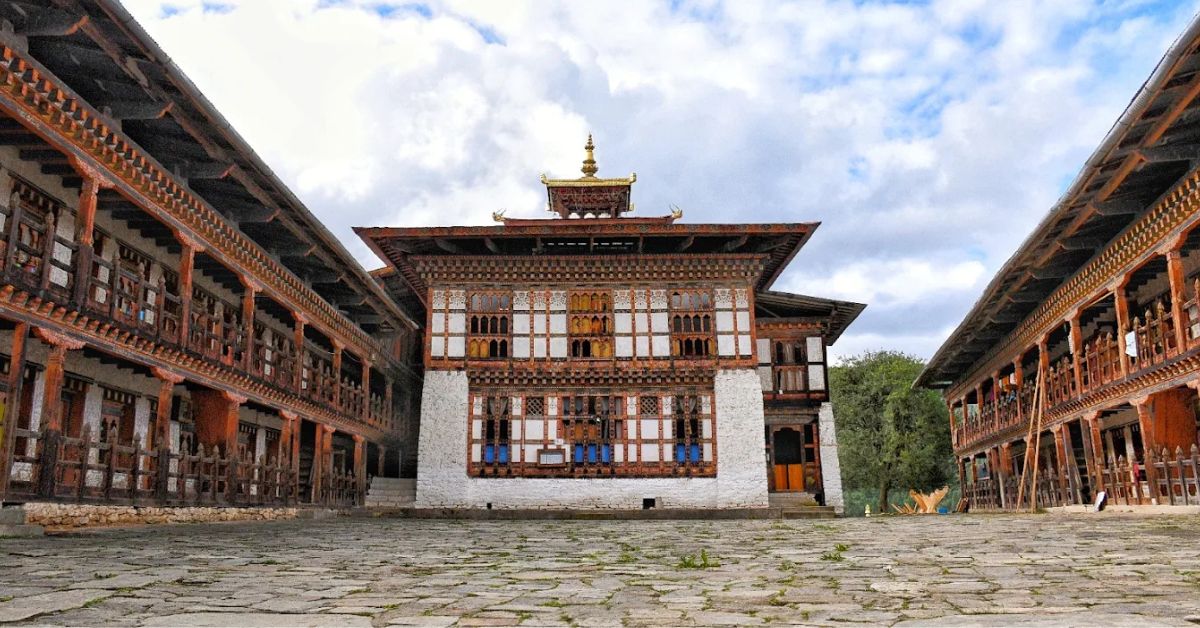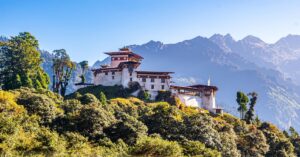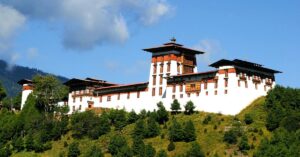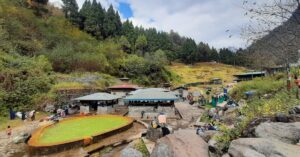Nimalung Monastery, also known as Thubten Shedrup Dargay Choling Lhakhang, is a two-story temple founded by Doring Trulku Khyentrul Jamyang Kunzang in 1938. It is located on a Nyimalung hill, meaning “Sun Valley”, beyond Prakhar Lhakhang in Chumi, Bumthang, at around 2,800 meters above sea level.
The monastery is renowned for its vibrant murals depicting Nyingmapa and Drukpa traditions and houses a magnificent statue of Guru Rinpoche. His Majesty Jigme Wangchuck, the Second King of Bhutan, renovated and upgraded the Nimalung Goemba in 1940.
Today, the temple has a Sheydra (monastic school) with around 150 monks and a Drubdey (meditation center) and is famous for its annual festival, Nimalung Tshechu, featuring mask dances and the unveiling of a giant Thongdrol of Guru Rinpoche.
How To Reach Nimalung Monastery
Nimalung Monastery Dratshang is a 15-minute drive from the main town of Jakar in Bumthang.
Bumthang is connected by national roads to other major towns like Thimphu, Paro, and Punakha. You can also opt for the domestic flight from Paro International Airport to Bathpalathang Domestic Airport in Bumthang for your convenience.
It is 23 kilometers from Chamkhar town. Drive towards the Chumey Valley from the town. When you reach Chumme, take the road that diverts towards Nimalung Lhakhang, which takes less than 15 minutes to the monastery. You can also walk to Nyimalung Monastery, which takes approximately 30 minutes.
Sacred Relics to See at Nimalung Monastery
- Statue of Guru Rimpoche;
- A statue of Drolma;
- The 9-metre-long and 12-metre-wide Thongdrol of Guru Rinpoche;
- A collection of black hats used during Nimalung Tshechu;
- Murals & Paintings depicting Nyingmapa and Drukpa traditions, and Pema Lingpa lineage;
History of Nimalung Monastery
Nimalung Goemba was founded by Dorling Khyentrul, Jamyang Kunzang Chokyi Nyima, in 1938.
According to history, Dorling Khyentrul or Doring Tulku, following in the footsteps of his mentor Longchenpa, arrived at Tharpaling Monastery, determined to read the Kuenkhen Zoeduen one hundred times.
However, his fate changed when he was asked to preside over the funeral rites of Chumey Dasho Zhelngo Jamyang, father-in-law of His Majesty Jigme Wangchuck. During the funeral, Doring Trulku met Goempo Dorji, the son and hereditary heir of Chumey Zhelngo Jamyang.
Doring Khyentrul and Dasho Drungpa Gonpo Dorji had a formal meeting in 1933 to establish a Nyingma monastic school. After the talks, they agreed to establish a new monastery at Nimalung, the Valley of Sunshine, to further the teachings of the Buddha and the Longchen Nyingthik lineage in particular.
By 1934, the construction of the main temple, the Thubten Shaydrup Darjay Choling monastery, began with the support of Dasho Goempo Dorji.
However, the construction of the first and second floors of the monastery, both inside and out, was completed under the command of the second king in 1940.
Lam Pemala, a close disciple of Doring Tulku, served as the second abbot of Nimalung Monastery from 1993 to 2009. Today, Nyimalung Monastery is headed by Tenzin Yeshey Dorji, the Yangse of Chabje Dudjom Jigdrel Yeshe Dorji.
Description of Nimalung Monastery
The Nyimaliung monastery is a two-storey structure. It is adorned with murals from the Nyingmapa and Drukpa lineages, including the Dzogchen and Nyingthig lineages, paintings of Guru Rinpoche, the lineage of Terton Pema Lingpa, and numerous Buddhist gurus linked with the monastery.
The main relic of Nyimalung monastery is a statue of Guru Rinpoche on the ground floor. The shrine also houses a statue of Drolma (Tara) inside an amulet brought from Tibet. There is also a large metal box containing a Thongdrol of Guru Rinpoche in front of the altar. Behind the altar are collections of black hats. They are for the annual Nimalung Tshechu. The top floor of the monastery is a sacred shrine, Goenkhang, dedicated to the protective deities.
Nyimalung Monastic School (Shedra)
Nyimalung Dratshang also has a Lobdra, a monastic school for learning the Nyingma tradition. The Dratshang has about 150 monks, furthering the Nyingthik and Peling tradition of practices. They also learn the arts of medicine, pharmacy, mandala painting, torma making, calligraphy, reading, and writing, as well as meditation.
During the winter, the monks travel to Nimalung Dratshang in Gelephu, their winter residence in southern Bhutan.
The Nyimalung Dratshang monks also perform masked dances at the annual festival of Prakar Goenpa.
Nimalung Festival 2025
Nyimalung Tshechu is a 3-day annual festival held from the 8th to the 10th day of the 5th month of the Bhutanese calendar. It is performed on the Birth Anniversary of Guru Rinpoche in the courtyard of Nimalung Lhakhang. This year, it’s from 3rd to 5th July 2025.
During the Tshechu, masked dances such as the Black Hat Dance, the Three Ging, and the Drummers of Drametse are performed. Lama Norbu Gyamtso, Pema Lingpa’s sacred treasure text, is also recited. On the final day, the Thongdrol of Guru Rinpoche is unfurled for the public to receive blessings.
Another important festival held here is the Kaling Zhitro Drubchen. The Drupchhen was first initiated in Bhutan by Dorling Khyentrul. It is conducted from the 1st to the 15th day of the 1st Bhutanese month.
Best Time to Visit Nimalung Monastery
The best time to visit Nyimalung Monastery in Bumthang is during the annual Nimalung Tshechu festival. You can participate and observe the whole procession of rituals and ceremonies. During the festival, the monastery comes to life, with masked dances and traditional folk songs, showcasing the rich spiritual and cultural heritage of Bhutan. You can visit the major pilgrimage sites of Bumthang with the Bhutan Pilgrimage Package.
Conclusion
Nyimalung Monastery Dratshang, also known as Nimalung Lhakhang, is an important Nyingma monastery in Nimalung, a 15-minute drive from Jakar. The monastery was founded by Doring Trulku Jamyang Kunzang and Dasho Goempo Dorji in 1938. It serves as both a monastic school and a meditation center and conducts a famous annual festival called Nimalung Tshechu.
Enjoyed reading this blog?




